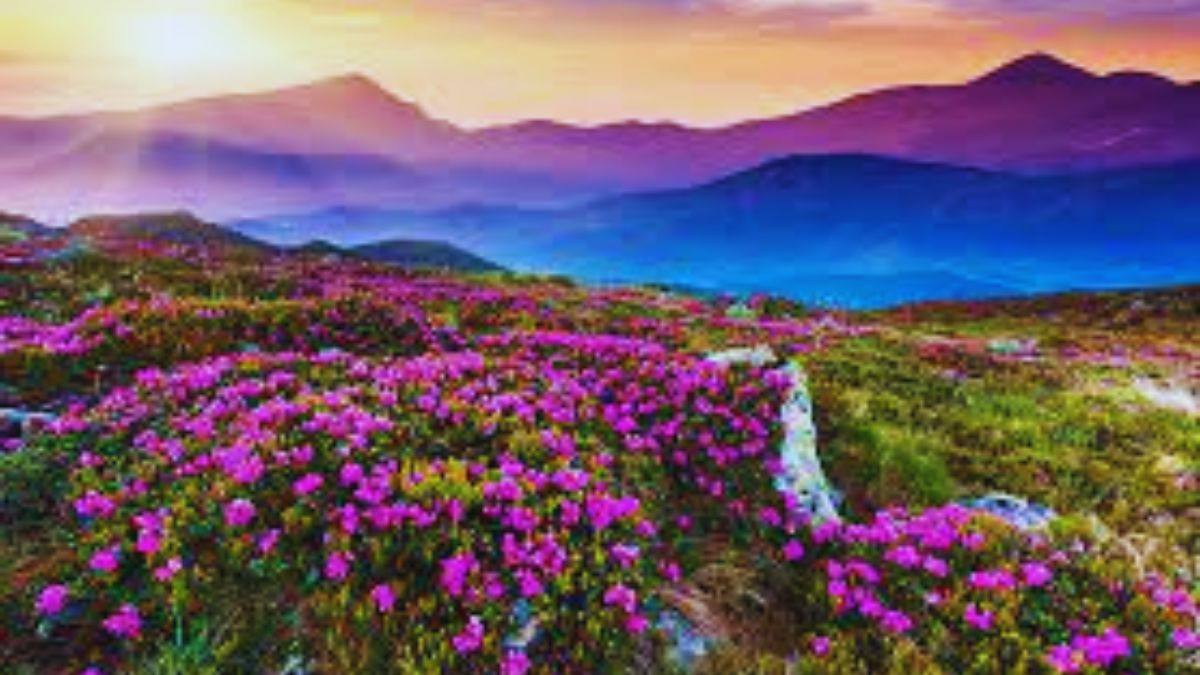Now is the best time to visit India in 2024: March
The Indian Meteorological Department (IMD) follows the international standard of four seasons, with some local adjustments: winter (December to February), summer (March to May), monsoon or rainy season (June to September), and a post-monsoon period (October and November). So, unlike many countries in the northern hemisphere, summer begins in March!
Summer in India is more than a season; it is a vivid spectacle. It’s a canvas painted in earthy browns, bright yellows, sky blues, and lush greens, punctuated by a kaleidoscopic explosion of mangoes, sunflowers, and bougainvillaeas.
The Interaction of Culture and Flora: Festivals and Flowers
In India’s vibrant summers, festivals like Holi and Vaisakhi (also pronounced as Baisakhi) showcase cultural diversity. Flowers, particularly jasmine in the south and the revered lotus in the east, are more than just decorations; they represent India’s deep connection with nature. Despite the scorching heat, the country’s spirit thrives, celebrating a harmonious blend of flora and festivities.

Summer Flowers in India: A Symphony of Seasonal Glory.
As summer in India rages on, casting its intense and sometimes relentless heat across the vast peninsular landscape, nature responds in the most enchanting way possible—through a burst of colours and fragrances from summer flowers.
These floras are more than just aesthetic symbols against the scorching sun; they tell a story of tradition, spirituality, and unity, striking a visual and symbolic balance between the human soul and the natural world.
In the midst of the sweltering heat, these flowers provide an oasis of beauty and symbolism, serving as metaphors for various aspects of life, including purity, love, passion, and hope.
A Symbol of Purity: The Lotus
In Indian mythology, the lotus flower symbolises purity, enlightenment, and cosmic balance. It is revered by deities such as Brahma, Lakshmi, and Vishnu and holds great sacred significance.
However, its allure is more than just symbolic; it is also culinary. The lotus graces Indian tables in the form of sweets, savoury foods, and ethereal garnishes, making each dish a feast for the soul and senses.
The Night Fragrance: Tuberose (Rajnigandha)
As dusk falls on Indian summers, Rajnigandha, or tuberose, releases its fragrant aria, making the night air heady like a whispered secret.
Adorning garlands at weddings and festivals, its scent—a blend of jasmine and gardenia—captures the essence of timeless Indian nights, transforming each moment into a nostalgic reverie.
The Sun Worshipper: Sunflower.
The sunflower, or Helianthus, a radiant symbol of Indian summer, represents energy and hope with its sun-seeking golden face. Aside from their cheer, its seeds are high in nutrition and are frequently toasted or milled for use in a variety of recipes.
Sunflower oil has recently emerged as a key ingredient in Indian cuisine, combining tradition with health benefits.
The Paper Flower, Bougainvillaea
The bougainvillaea is summer’s firework, draping walls and arches in bright pink and orange. Nicknamed the ‘Paper Flower,’ its delicate bracts conceal a sun-loving resilience.
Its colourful flamboyance can be easily shaped into trellises or pots, making it suitable for both garden sculpture and festive decor.
Marigold is a symbol of sunlight and passion.
In India, no religious or cultural ceremony is complete without the presence of the beautiful marigold. Its vibrant colours, ranging from golden-yellow to deep orange, are associated with the sun, a symbol of life and energy.
Marigold garlands are popular at weddings, festivals, and rituals and are used to decorate homes, temples, and even vehicles. Marigolds, with their distinct, lingering fragrance that sanctifies India’s summer, create a sense of sanctity and celebration wherever they are placed.
Echoes of Tradition and Reverence: Hibiscus
The hibiscus is deeply rooted in tradition and reverberates with the songs of traditions and reverence that hold religious significance, particularly in the worship of Goddess Kali, which is offered as a symbol of devotion.
Its extracts are an essential component of Ayurveda, the traditional system of Indian medicine, and can be found in hair care remedies as well as culinary preparations, truly reflecting India’s multifaceted relationship with nature and culture.
Captivating fragrance: jasmine.
Jasmine’s understated elegance conceals an intoxicating allure. This simple flower, deeply rooted in Indian culture, represents purity and divine hope.
Beyond its poetic references, jasmine’s association with love is evident in bridal bouquets and fragrant hair adornments. It captures the essence of Indian summers, striking a delicate balance between boldness and charm.
Tropical Elegance: Plumeria (Frangipani).
In Indian folklore, plumeria is a symbol of immortality, with its intoxicating scent and sun-hardy nature echoing our eternal spirit. Its petals adorn gods in legends and enhance divine beauty.
These five-petaled gems bloom in the summer and adorn gardens and streets, their ethereal fragrance and tropical allure providing a taste of paradise on Earth.
Everlasting Beauty in the Scorch: Rose.
The rose is a well-known flower that has a universal appeal. Even in the hot Indian summers, varieties like Damask rose, Multiflora, Noisette, and Desi Gulab thrive. The rose, a symbol of love, passion, and beauty, has a timeless allure.
Roses are frequently seen on the hands of deities in Indian mythology, representing divine love and blessings. They are commonly woven into wedding garlands, representing the eternal bond and beauty of love in the face of life’s challenges.
The Aromatic Allure of Champa (Magnolia Champaca)
The botanical name, Magnolia Champaca, describes the golden glory of Indian summers. Its vibrant yellow petals and surreal aroma make it one of the most popular flowers in Indian culture.
Champa, a common motif in Indian literature, is frequently associated with love and longing, making it a powerful emotional symbol.
Champa is commonly used in rituals and offerings, and its scent is thought to please the gods. As the gentle breeze of dusk carries the aroma, it whispers stories from ancient India—of lovers united under its shade and poets enchanted by it.
Flamenco of the streets: Gulmohar (Flamboyant).
The Gulmohar, aptly nicknamed ‘Flamboyant,’ dances with the wind like a flamenco performer, its vibrant red and orange petals evoking India’s spirit.
In a country where colour symbolises celebration, the Gulmohar is a living tapestry of zeal and resilience, proclaiming that life should be lived vividly, no matter what.
Its blossoms are more than just a sight; they are a radiant reflection of a culture full of passion and energy.
Nature’s Palette: Lantana Lantanas symbolise India’s resilience and diversity. Braving the harshest sun, they thrive where others fail, emitting colours ranging from bright yellows to fiery reds that echo India’s diverse tapestry.
Their vibrant petals appear to host a miniature funfair, celebrating life and colour despite adversity. Lantanas, like India, remain unwavering and vibrant.
Rain Awaiters: Balsam
Balsam flowers dance on tiptoe, their colours a prelude to the monsoon symphony. They do not wilt as India’s sun shines brighter; instead, they crescendo in vivid anticipation.
Balsam is more than just flora for those who have to endure the scorching heat; it is a kindred spirit, a poetic symbol of life’s cycles.
They wait together for the first drop of rain, which signals the earth to dance in purple and green.
Beyond the aesthetics: health benefits of summer flowers
India, as a land of diverse traditions, not only appreciates the visual appeal of its summer flowers but also values their numerous health benefits. Flowers play an essential role in India’s wellness culture, from Ayurvedic holistic perspectives to wisdom passed down through generations. Let’s look at a few.
Lotus seeds, high in antioxidants and vitamins, are thought to promote digestive health and reduce stress. The roots are commonly consumed in salads and are high in nutrients that can boost your immune system.
Tuberose has both a seductive nocturnal fragrance and anti-inflammatory properties. Its essential oil is commonly used in aromatherapy to relieve stress and promote relaxation.
Sunflower seeds are a nutritious snack high in vitamin E, which is necessary for healthy skin. Sunflower petals are used in balms and ointments for their antiseptic properties, which aid in wound healing.
Jasmine and Hibiscus:
Jasmine tea is revered for its calming effects and potential to lower blood pressure, whereas hibiscus tea is frequently recommended for its vitamin C content and cholesterol-lowering properties.
Plumeria is recognised in Ayurveda for its anti-inflammatory and antioxidant benefits.
Balsam extract is a traditional remedy for skin diseases.
Gardening during the Indian Summer: Nurturing the Blooms
Summer in India is an enchanting season of intensity and fervour, with a rhythm that speaks of vibrant colours, sweltering afternoons, and a magnetic allure that attracts both flora and human spirits.
The canvas of nature transforms during this season, and so should our approach to gardening, especially given India’s diverse climates and rich floral biodiversity.
Crafting Your Own Floral Summer Experiences
Creating your own floral oasis during India’s vibrant summer is like writing a personal symphony, with each bloom playing a distinct note that speaks to your soul. Begin with a summer floral journal to better understand your garden’s potential and your own preferences.
Perhaps a Lotus Pond serves as your spiritual sanctuary, while Marigolds add festive cheer indoors. Consider maintenance, as the joy of caregiving is part of the appeal. Floral mandalas allow you to express your artistic side, while edible floral delights allow you to explore your culinary side.
Finally, each petal, scent, and colour become a carefully curated element in your own immersive Indian summer masterpiece.




